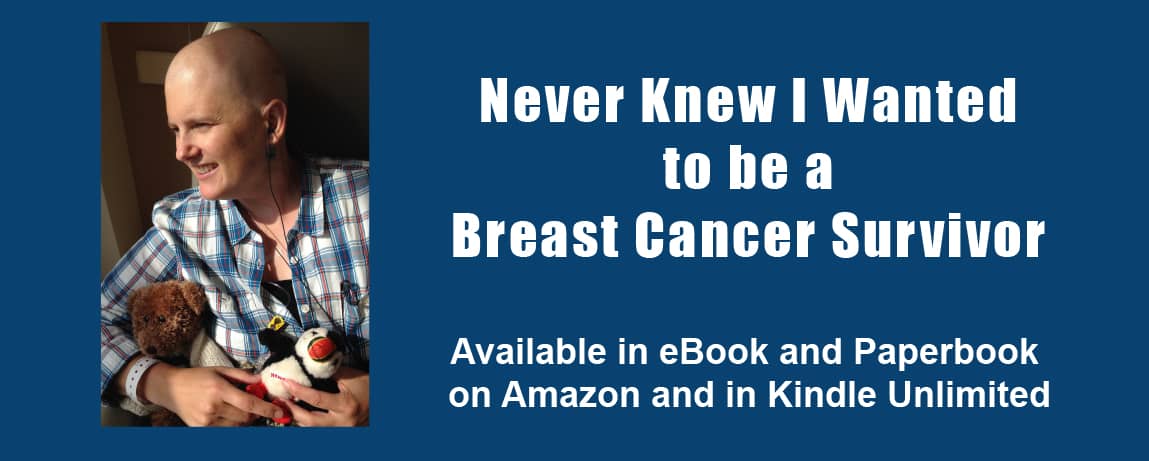This post is a continuation on my discussion about Patient Health Literacy. The narrative that resulted from this study has been published on Amazon. See my Memoir page. The original source that I used for my study can be found at https://bcbecky.com.
From among the 237 blog posts, I coded 163 (68.8%) with the category, Developing coping mechanisms. The distribution of the number of days per week that I wrote one or more posts that were coded as Developing coping mechanisms, Figure 2, shows that from the very beginning and throughout treatment I blogged about coping mechanisms. There are dips that align with the weeks where I wrote fewer posts overall and can be attributed to times where I was travelling or having surgery.

In reviewing the posts categorized as Developing coping mechanisms, I constructed the following themes: (1) blogging, (2) exercising, (3) social networking, and (4) seeking control. The theme blogging applies to posts where I write about or reflect upon the act of blogging. The theme exercising applies to posts where I write about exercising including hiking and being in nature. The theme social networking applies to posts where I write about connections with others that provide me support. The theme seeking control applies to posts where I am writing about ways that I try to find aspects of disease experience where I can create a sense of control. I discuss these themes in more details in the following sections.
Blogging
In the beginning, I highlight that I began blogging as a way to share my thoughts, as I was a blogger before diagnosis, I found myself wanting to write and share my experiences as a way to process what was happening to me, specifically I say “I shall look at this blog as a journal into lived experience, combining medical jargon with lived-experience of someone with breast cancer” (It all started …, June 14, 2014). A few days after diagnosis, I discovered another benefit to blogging, specifically that I didn’t have to keep telling people what was going on. I wrote “Mostly I’m pointing people to my blog, just so I don’t have to keep saying it. There is an emotional toll that occurs on both sides. Some people want to reach out and talk, but I’m not there yet. I cannot talk about it.” (A tough day, June 17, 2014). Later, I write about my intention to use my blog as a way to exercise my brain when I was worried about the effects of chemotherapy on my cognitive function. I wrote: “I shall keep up my ‘exercise’ and try to write regularly. I can only hope that my words continue to make sense and continue to demonstrate some level of cognitive competence” (Reflection on chemo brain, September 15, 2014).
I talk explicitly about the blogging process at the beginning of the treatment process, but then stop writing about the blogging process as treatment progressed. This suggests that my reflections on blogging itself became normalized as treatment progressed, that is, that I no longer felt it necessary to reflect on how blogging was affecting me.
Exercising
From the beginning, I recognized exercise as a priority, noting that I wanted to get as strong as possible before treatment began. Specifically, I say:
As time progressed, I added hiking to my repertoire of exercise. I especially found exercising in nature as a way to feel both physically and mentally better. I highlight the effect of hiking in a grove of ancient redwood trees:
Unfortunately, the side effects of chemotherapy caught up to me as I had mouth sores that made it impossible for me to effectively hydrate, which in turn curtailed my ability to exercise (Not talking = not blogging, August 30, 2014). After surgery, I returned to regular exercise as a way to recover:
Further, post-surgery I was thankful for all the time I spent exercising during chemotherapy, because “when I took my first steps, my legs were strong. It made a huge difference to how quickly I was able to move, and how quickly I’ve been able to walk.” (A small cup of coffee, January 2, 2014).
Social Networking
Initially, I was very hesitant about joining any breast cancer communities. It was my husband who pushed me to attend my first support group meeting, only a few days after my diagnosis. In Support group (June 22, 2014), I express how attending the support group helped me learn to talk about my cancer. I had to say it out loud. It also gave me a space to talk about breast cancer with others who understood what I was going through.
Further, in Joining the cancer blogsphere (July 6, 2014), I expressed my hesitation in joining the breast cancer blogosphere:
Despite my hesitance to reach out to new support communities, my posts show that I did reach out to my pre-existing social networks for support. For example, when I found that I needed support to overcome inertia and side effects in order to exercise, I called on friends to help keep me accountable and help me get off the couch using a personal Facebook exercise support group (Significance of dates and getting ready for chemo, June 26, 2014).
Further, the importance of social networking as a coping mechanism was suggested when I blogged about the role of social media in my process of gathering information about breast cancer and treatment options. In Social media and patient engagement (October 29, 2014), I outline what type of information I gathered from social media:
In addition to using my social network for outside support, my blog also highlighted the importance of having a caregiver to provide support when I was not able to make decisions for myself. The impacts of cancer and chemotherapy on my mental capacity meant that I could no longer troubleshoot when unexpected events occurred. My husband, Scott, was my rock and was there to ensure continuity of care. After my first surgery, where he could stay the night in my hospital room which “turned out to be very useful, as several times I benefitted from having a patient advocate (things like helping when I needed to use the toilet). It also meant that he was here for most of the doctor and nurse visits.” (An update from the hospital, November 20, 2014). Further, caregiver support was highlighted when I blogged about the challenges of returning home after my second surgery:
Seeking Control
Initially one of the ways I exhibited the theme seeking control was through intentionally finding ways to have fun. This became an explicit activity. I knew that if I didn’t find ways to have fun then treatment would be very difficult: “One of the things that causes that natural high for me is sailing. So, we are looking for ways to go sailing regularly. However, sailing can be very physically demanding, which will likely be a challenge. This Saturday, we are headed up to the city to go sailing on a 2003 America’s Cup boat.” (Priorities, June 18, 2014).
In addition to intentional fun, I also had to explicitly give myself permission to do things. Initially, it was giving myself permission to nap (I had to give myself permission to nap, July 9, 2014). As the idea of surgery approached “I have given myself permission to go into surgery kicking and screaming. I’m OK with not being calm and collected when I get rolled into surgery. It is natural to not want to deal with it.” (I’m scared, September 17, 2014).
After I began chemotherapy treatment, one of the ways I attempted to regain a sense of control was to shave my head prior to losing all my hair. I explain this decision:
Further, to help plan for chemotherapy side effects, I created a chart of my symptoms, see Image 1, which I used to help predict when I was going to experience the different side effects in future chemotherapy cycles. I also used the chart to determine which steps I should take to proactively reduce the impact of the side effects (Mouth sores & first cycle symptoms, July 20, 2014).

Perhaps one of the more pragmatic attempts at seeking control was through planning. Unfortunately, the unpredictable nature of chemotherapy treatment meant that some of the plans I had originally made, specifically my original plans for a trip to Hawaii, would no longer work. Additional planning was required regarding the new treatment schedule:
Finally, the post-surgery posts in seeking control relate to advocating for myself during interactions with the healthcare system. Specifically, I wrote about negotiating with a resident regarding a surgical side effect, and my unwillingness (non-compliance) to take her recommendation:
Summary
One of the important aspects of health-related self-efficacy around cancer care is the need for the patient to develop coping mechanism (Papadakos, 2017). In my theme analysis of the category Developing coping mechanisms, I show that I continually developed coping mechanisms throughout treatment. Under the category of Developing coping mechanisms, I constructed four themes (1) blogging, (2) exercise, (3) social networking, and (4) seeking control. Blogging was initially a way in which to help me process and share my treatment decisions. Later, blogging became a way of exercising my mind, where physical exercise provided a way for me to feel physically and mentally better. Throughout the study period, I found support in both face-to-face and online social networks. The theme social networks also included support that I received from my husband and primary caregiver. Finally, I blogged about the ways in which I sought control, including intentionally planning fun activities and travel. Control seeking was also expressed through self-advocacy.
My analysis of the category Developing coping mechanisms showed that I continually developed coping mechanisms throughout treatments. Although each individual chooses to cope in different ways (Al-Azri, Al-Awisi, & Al-Moundhri, 2009), blogs such as mine provide a great resource for discovering what coping mechanisms might be useful. A practice that I developed through my experience was to develop coping mechanisms such as blogging, social networking, exercising, and seeking control. Patients experiencing critical or chronic illness have a need to develop coping mechanisms in order to learn how to live with illness.
References
Al‐Azri, M., Al‐Awisi, H., & Al‐Moundhri, M. (2009). Coping with a diagnosis of breast cancer‐literature review and implications for developing countries. The breast journal, 15(6), 615-622.
Papadakos, J. K. (2017). The Association of Health Literacy and Self-Efficacy to Cancer Chemotherapy Self-Management Behaviours and Health Service Utilization. Doctor of Philosophy.
Are you a patient? Do these coping mechanisms align with your experience? What other types of coping mechanisms did you develop?


Leave a Reply